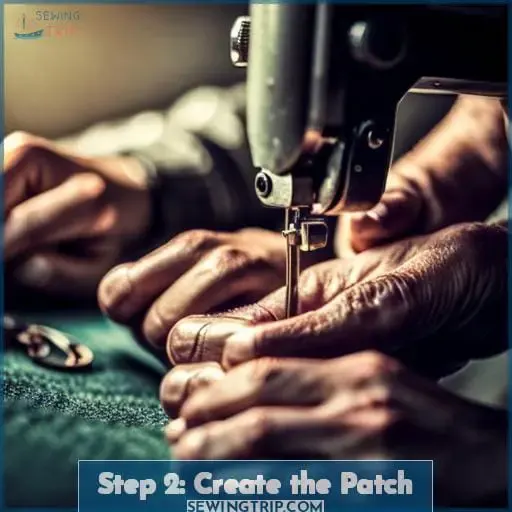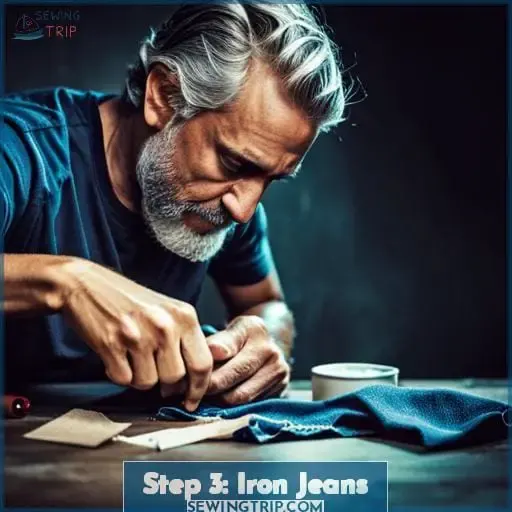This site is supported by our readers. We may earn a commission, at no cost to you, if you purchase through links.
Having the right pair of jeans can make you feel like a million bucks. But what happens when your favorite pair develops an unsightly hole in the knee? According to a recent survey conducted by Unilever, more than half of respondents admitted they would discard their beloved denim rather than attempt to repair it.
But fear not! With just a few supplies and some basic sewing skills, you can easily patch up those holes and keep on wearing your favorite pants.
In this article, we’ll show you how to patch a knee hole in pants with our step-by-step guide for 2023.
Table Of Contents
Key Takeaways

- Basic sewing skills and supplies are needed to patch knee holes in pants.
- The patch should extend at least 1 inch beyond the damaged area to reduce tension.
- Zig-zag stitching with matching thread is important for security and to fill in gaps between the patch and existing material.
- Preshrunk denim or other heavyweight fabrics work best for durability, and overcast stitching can prevent fraying.
Fixing Jeans With a Hole

You can quickly and easily fix a torn area in your jeans with just a few simple steps, so you don’t have to break the bank buying new clothes.
First, grab some scrap denim fabric for the patch and make sure it is of similar weight as your jeans. Then use an ironing technique to turn the jeans inside out before sewing on the patch.
Place it over the hole, making sure that its edges extend at least 1 inch beyond where there is no damage. This will help reduce tension points by rounding off corners or cutting them into curves instead of sharp angles.
Use a zig-zag stitch around both sides of the hemline edging for security, then finish up with another zig-zag stitch to fill in any remaining gaps between patches and existing material.
Finally, if you have access to one, using a sewing machine will speed up this process even more. But be careful not to use lightweight cotton fabrics, which could fray when washed or worn heavily over time.
Step 1: Materials Needed
Gather the materials you’ll need to repair the tear in your jeans, such as scrap denim fabric of similar weight and a sewing machine if available. But do remember that lightweight cotton fabrics are not recommended. Are there other alternatives? Embellishing patches with thread matching is a great way to add more character.
Additionally, make sure the fabric weight is right for the job and adjust the iron temperature accordingly when using one for pressing. For extra strength, consider an oval template when cutting out corners of patch pieces or use overcast stitch on bottom-weight fabrics like terry cloth or velvet too.
With all these tools, you will have everything necessary under control, so get started on fixing those holes quickly before it’s too late!
Alternative Fabrics
When it comes to patching a knee hole in pants, there are some alternative fabrics you can use. Preshrunk fabrics, such as denim patches, tend to work the best for this kind of repair job since they maintain their shape and won’t shrink further when washed.
Make sure that your thread matches the color of your fabric too. Traditional repairs require thread matching for an even look! For extra strength and fraying prevention, incorporate zig-zag stitching around both sides of the patch area.
Alternatively, opt for a calico patch with overcast stitch on bottom-weight materials like terrycloth or velvet.
Just be careful not to choose lightweight cottons as these may not last long under pressure from everyday wear and tear! With all these tips in mind, you’re now ready to start mending those holes up quickly before any more damage is done!
Step 2: Create the Patch
Now it’s time to make a sturdy fabric patch that extends at least 1 inch beyond the edge of the hole. Begin by cutting out your patch in either a square or circular shape, depending on the size and shape of your hole.
Choose preshrunk fabrics like denim for durability and to prevent further shrinkage when washed.
To reduce tension points around corners, consider rounding them off with scissors first before attaching with stitching patterns such as zig-zag or blanket stitch.
Don’t forget to match the thread color with whatever fabric choice you’ve made. This ensures an even look all around after completion.
Now take these tips into account and begin mending those pants quickly so they can get back on track again soon!
Step 3: Iron Jeans
Before you start stitching, make sure to iron the jeans inside out with a low heat setting. This will help ensure your patches stay in place! The thread color should be matched to the denim fabric of your pair of jeans.
For an extra secure patch, use a medium-high heat setting on an iron or sewing machine. If you’re using new fabric for repairs, pre-shrink it first and choose something like denim that won’t shrink further when washed.
Also, remember that exposed white threads can easily snag, so create a tidy oval patch shape if possible. This helps reduce tension points around corners too! To finish off with perfectly neat edges all around, consider using zigzag or blanket stitch patterns.
In short, take care while prepping those pants and don’t forget about attention to detail before getting started with mending them up again!
Step 4: Overcast
Now, quickly strengthen the patch with an overcast stitch to prevent future fraying – so fast your head will spin!
For this small repair project, you’ll need a thread choice that matches the denim fabric and a needle size appropriate for the fiber of the fabric. Also, pay attention to stitch length as too long can cause bunching or puckering on areas such as stretch denim.
When selecting fabrics for patches, choose something heavyweight like classic leather elbow patches rather than lightweight cotton varieties.
As you go along, make sure to create a tidy oval shape around holes if possible, which helps reduce tension points at corners and makes it easier when doing basic running stitches afterwards.
Keep in mind all tools must be used correctly in order for successful results – focus on details while sewing up those jeans!
Step 5: Zig Zag
Next, use a zig-zag stitch to secure the patch and fill in the hole – it’s easy and only takes a few minutes!
Start by making sure you’re stitching on the right side of your garment. Choose heavyweight fabric for patches, like classic leather elbow patches, instead of lightweight cotton varieties. Also, remember to use thread that matches the denim fabric and an appropriate needle size for its fiber.
It’s important to select the right stitch length, as stitches that are too long can cause bunching or puckering, especially on stretch denim.
Once you’re done, try to create an oval shape around the holes if possible. This helps reduce tension points at the corners, making it easier to do basic running stitches later on. Before moving on to the next step, take a moment to adjust any slanting hemming stitches to ensure everything looks neat.
Now, it’s time for the hard-worked repair of the worn hole. Use a spiral pattern of zigzag stitching around the edges.
Step 6: Finished
You’ve completed the process! Now, your stitched masterpiece will last a lifetime – effortlessly mending together what was once torn apart.
To get the best results with patching techniques, consider these points:
- Thread choice is important; choose something that matches the denim fabric and an appropriate needle size for its fiber.
- Fabric selection should be heavyweight like classic leather elbow patches instead of lightweight cotton varieties.
- Use a sewing machine to ensure neatness or you can use adhesive tape if desired.
- Create an oval hole around the edges to reduce tension points at corners and make it easier to do running stitches later on.
- For added security, try using cardboard punch-outs as well as ironing processes inside out before stitching with zigzag patterns in spiral form around holes.
You have now successfully patched up those jeans! You didn’t only save money but also showed off some professional skills in patching knees of jeans, which could easily pass off as brand new ones!
Frequently Asked Questions (FAQs)
How long does it take to patch a knee hole in jeans?
Patching a knee hole in jeans doesn’t take long. With the correct materials and proper technique, you can easily mend your torn pants quickly and safely – giving you peace of mind faster.
Is it possible to patch a knee hole in jeans without a sewing machine?
Yes, it is possible to patch a knee hole in jeans without a sewing machine. With the correct materials and tools, you can secure the patch with an overcast stitch or zig-zag stitching around the edges of your jeans.
Can I use any color thread for patching the jeans?
You can use any color thread for patching jeans, but make sure it matches the denim to create a seamless look. Choose thread that is strong enough to hold the patch in place and prevent fraying. For best results, choose a neutral shade or one slightly darker than your jeans fabric.
How do I know which fabric is best for patching jeans?
Choose a fabric that is strong and durable, such as denim or canvas. Avoid lightweight cottons as they may fray quickly.
How can I make sure the patch stays in place after washing the jeans?
To ensure that your patch stays in place, make sure the fabric is sturdy, use an overcast stitch to secure it, and take extra care when washing.
Conclusion
Now that you have all the steps down, you can confidently patch up any holes in your jeans. It may take a bit of time and patience, but with practice, you’ll be amazed at the results. So don’t be afraid to grab a needle and thread and get to work! It’s time to turn those old jeans into something new – like the Phoenix rising from the ashes.
With this newfound skill, you’ll be able to save your money and keep your jeans looking good for years to come.













